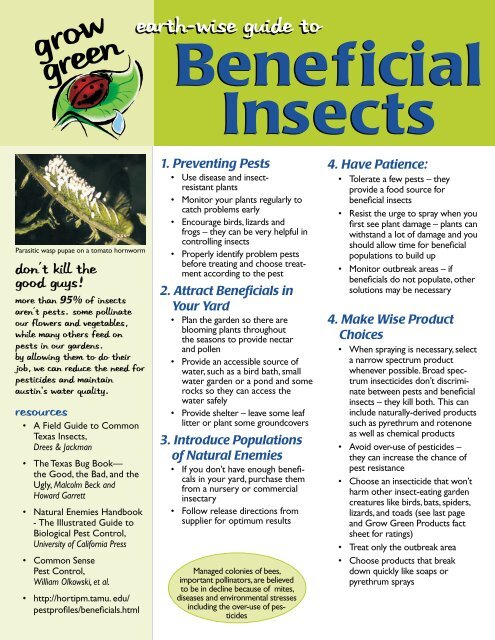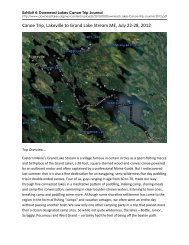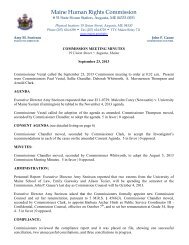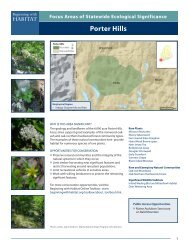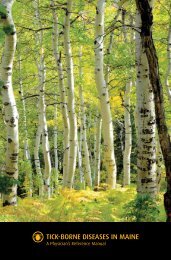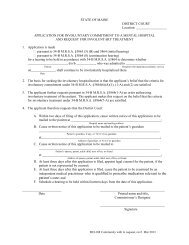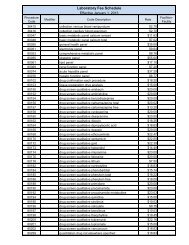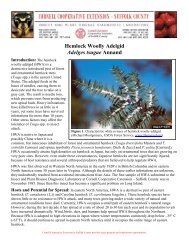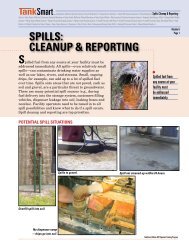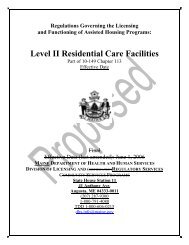Earth-wise Guide to Beneficial Insects - Maine.gov
Earth-wise Guide to Beneficial Insects - Maine.gov
Earth-wise Guide to Beneficial Insects - Maine.gov
Create successful ePaper yourself
Turn your PDF publications into a flip-book with our unique Google optimized e-Paper software.
earth-<strong>wise</strong> guide <strong>to</strong><br />
<strong>Beneficial</strong><br />
<strong>Insects</strong><br />
Parasitic wasp pupae on a <strong>to</strong>ma<strong>to</strong> hornworm<br />
don’t kill the<br />
good guys!<br />
More than 95% of insects<br />
aren’t pests. some pollinate<br />
our flowers and vegetables,<br />
while many others feed on<br />
pests in our gardens.<br />
By allowing them <strong>to</strong> do their<br />
job, we can reduce the need for<br />
pesticides and maintain<br />
Austin’s water quality.<br />
resources<br />
• A Field <strong>Guide</strong> <strong>to</strong> Common<br />
Texas <strong>Insects</strong>,<br />
Drees & Jackman<br />
• The Texas Bug Book—<br />
the Good, the Bad, and the<br />
Ugly, Malcolm Beck and<br />
Howard Garrett<br />
• Natural Enemies Handbook<br />
- The Illustrated <strong>Guide</strong> <strong>to</strong><br />
Biological Pest Control,<br />
University of California Press<br />
• Common Sense<br />
Pest Control,<br />
William Olkowski, et al.<br />
• http://hortipm.tamu. edu/<br />
pestprofiles/beneficials.html<br />
1. Preventing Pests<br />
• Use disease and insectresistant<br />
plants<br />
• Moni<strong>to</strong>r your plants regularly <strong>to</strong><br />
catch problems early<br />
• Encourage birds, lizards and<br />
frogs – they can be very helpful in<br />
controlling insects<br />
• Properly identify problem pests<br />
before treating and choose treatment<br />
according <strong>to</strong> the pest<br />
2. Attract <strong>Beneficial</strong>s in<br />
Your Yard<br />
• Plan the garden so there are<br />
blooming plants throughout<br />
the seasons <strong>to</strong> provide nectar<br />
and pollen<br />
• Provide an accessible source of<br />
water, such as a bird bath, small<br />
water garden or a pond and some<br />
rocks so they can access the<br />
water safely<br />
• Provide shelter – leave some leaf<br />
litter or plant some groundcovers<br />
3. Introduce Populations<br />
of Natural Enemies<br />
• If you don’t have enough beneficals<br />
in your yard, purchase them<br />
from a nursery or commercial<br />
insectary<br />
• Follow release directions from<br />
supplier for optimum results<br />
Managed colonies of bees,<br />
important pollina<strong>to</strong>rs, are believed<br />
<strong>to</strong> be in decline because of mites,<br />
diseases and environmental stresses<br />
including the over-use of pesticides<br />
4. Have Patience:<br />
• Tolerate a few pests – they<br />
provide a food source for<br />
beneficial insects<br />
• Resist the urge <strong>to</strong> spray when you<br />
first see plant damage – plants can<br />
withstand a lot of damage and you<br />
should allow time for beneficial<br />
populations <strong>to</strong> build up<br />
• Moni<strong>to</strong>r outbreak areas – if<br />
beneficials do not populate, other<br />
solutions may be necessary<br />
4. Make Wise Product<br />
Choices<br />
•<br />
•<br />
•<br />
•<br />
•<br />
When spraying is necessary, select<br />
a narrow spectrum product<br />
whenever possible. Broad spectrum<br />
insecticides don’t discriminate<br />
between pests and beneficial<br />
insects – they kill both. This can<br />
include naturally-derived products<br />
such as pyrethrum and rotenone<br />
as well as chemical products<br />
Avoid over-use of pesticides –<br />
they can increase the chance of<br />
pest resistance<br />
Choose an insecticide that won’t<br />
harm other insect-eating garden<br />
creatures like birds, bats, spiders,<br />
lizards, and <strong>to</strong>ads (see last page<br />
and Grow Green Products fact<br />
sheet for ratings)<br />
Treat only the outbreak area<br />
Choose products that break<br />
down quickly like soaps or<br />
pyrethrum sprays
Assassin Bug<br />
Good Guys<br />
Pho<strong>to</strong>s by Lisa Lennon and Wizzie Brown<br />
Damsel Bug<br />
Damsel Fly<br />
Ground Beetle – Scarab Beetle<br />
Lady Beetle<br />
Preda<strong>to</strong>ry Flies – Robber Fly<br />
Lacewing<br />
Long-legged Fly<br />
Spiders<br />
Preda<strong>to</strong>ry Wasps – Red Wasp<br />
Praying Mantis<br />
Syrphid Flies<br />
Honey Bees<br />
Giant Wheel Bug
Assassin<br />
Bug<br />
Larvae and adults:<br />
• Beetles<br />
• Caterpillars<br />
• Many other pests<br />
Some Common <strong>Beneficial</strong> <strong>Insects</strong>:<br />
Insect Food Source Description<br />
Attracted <strong>to</strong>:<br />
Damsel<br />
Bugs<br />
Nymphs and adults:<br />
• Caterpillar eggs<br />
• Small larvae<br />
• Fleahoppers<br />
• Leafhoppers<br />
• Spider Mites<br />
Large eyes; excellent hunters<br />
Nymphs: similar <strong>to</strong> adults but without wings;<br />
wings develop as insect matures<br />
Sunflowers<br />
Clover<br />
Damsel<br />
Flies<br />
Adults:<br />
• Mosqui<strong>to</strong>s<br />
• Gnats<br />
• Other flying insects<br />
Black <strong>to</strong> reddish-brown or metallic, small <strong>to</strong><br />
medium, fast-moving insects;<br />
Water<br />
Ground<br />
Beetles<br />
Larvae and adults:<br />
• Snails<br />
• Slugs<br />
• Root-feeding insects<br />
Feed at night<br />
•<br />
•<br />
•<br />
S<strong>to</strong>ne pathways<br />
White clover<br />
Compost piles<br />
Lacewings<br />
Green or Brown<br />
•<br />
•<br />
•<br />
•<br />
Aphids<br />
Small Caterpillars<br />
Whiteflies<br />
Thrips<br />
Green: lay eggs on long stalk<br />
Brown: lay tiny eggs on leaves near aphids<br />
their food source<br />
Nectar-producing plants like:<br />
• Scented geraniums<br />
• Roses<br />
Lady<br />
Beetle<br />
(Ladybugs)<br />
Larvae and adults:<br />
• Aphids<br />
• Scales<br />
• Mites<br />
• Other soft-bodied insects<br />
Larvae: wingless, spiny: orange and<br />
black markings<br />
Adults: red or orange with dark spots or<br />
black with two red spots or no spots<br />
Nectar-producing plants like:<br />
• Tansy<br />
• Scented geraniums<br />
• Tropical milkweed<br />
Preda<strong>to</strong>ry<br />
Flies<br />
Adults:<br />
• Caterpillars<br />
• Beetle larvae<br />
• Sawflies<br />
Examples:<br />
• Robber Fly: large head, prominent eyes,<br />
long legs, thin abdomen<br />
• Long-legged Fly: medium <strong>to</strong> small, slender,<br />
with green, blue or copper metallic<br />
colored bodies and long legs<br />
Nectar-producing plants<br />
Preda<strong>to</strong>ry<br />
Wasps<br />
Praying<br />
Mantis<br />
Most insect groups<br />
Nymphs: many pests and beneficials<br />
Adults:<br />
• Flies<br />
• Bees<br />
• Crickets<br />
• Moths<br />
Examples:<br />
• Red Wasps (see picture): red bodies with<br />
black wings, “paper” nest<br />
• Yellowjackets: ½ inch long wasp,<br />
with clear wings, yellow and black,<br />
shorter legs<br />
Nymphs: similar <strong>to</strong> adult but without wings;<br />
wings develop as insect matures<br />
Pollen-producing plants with tiny<br />
flowers like:<br />
• Caraway<br />
• Fennel<br />
• Tansy<br />
Flower and vegetable gardens<br />
Spiders<br />
•<br />
•<br />
•<br />
Flying insects<br />
Caterpillars<br />
Others<br />
Arachnids: have eight legs, various sizes, usually<br />
specialized as either roaming hunters or<br />
web builders; many are harmless<br />
Flower and vegetable gardens<br />
Syrphid<br />
Flies<br />
Larvae:<br />
• Aphids<br />
• Caterpillars<br />
• Beetles<br />
• Thrips<br />
Larvae: creamy-white <strong>to</strong> green or brown<br />
Adults: 1 / 4 <strong>to</strong> 3 / 4 ”, black or brown with<br />
yellow-banded abdomens; resemble small<br />
wasps or bees but only have two wings<br />
Composite flowers like:<br />
• Dill<br />
• Fennel<br />
• Coreopsis<br />
• Feverfew<br />
Honey<br />
Bees<br />
Pollen and flower nectar<br />
Not aggressive if left alone; they are necessary<br />
for fruit-producing plants in the vegetable<br />
garden such as squash, watermelons, and okra<br />
Pollen and nectar-producing<br />
flowers like:<br />
• Asters<br />
• Black-eyed Susans<br />
• Goldenrod<br />
Giant<br />
Wheel<br />
Bug<br />
Nymphs and adults:<br />
• Caterpillars<br />
• Moths<br />
• Squash bugs<br />
• Cucumber beetles<br />
Nymphs: similar <strong>to</strong> adult but brightlycolored;<br />
don’t have a crest<br />
Adults: 1 <strong>to</strong> 1 1 / 4 ”, grey <strong>to</strong> brown<br />
Live in shrubs and trees


